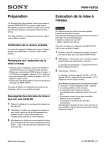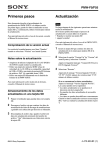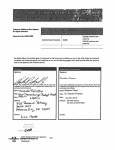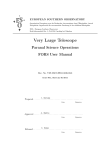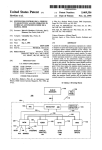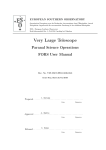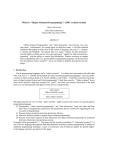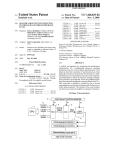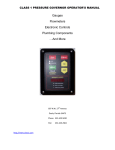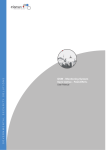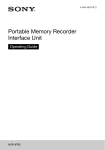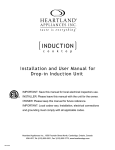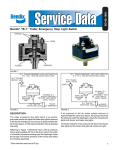Download Current controlled fluid bleed
Transcript
lllllllllllllllllIlllllllllllllllllllIlllllllllllllllllllllllllllllllllllll _ US00510579OA UI'lltEd States Patent [19] [11] Patent Number: Nye, Jr. [45] [54] CURRENT CONTROLLED FLUID BLEED [76] Inventor! Dudley D- Nye! Jr" 4020 631‘ Ocean Dl'w #6O61FOYT Lauderdale, Fla33308 5,105,790 Date of Patent: Apr. 21, 1992 OTHER PUBLICATIONS Moore Products Co. Spring House, Pa., Model 771, UP Transducers Installation/Service Manual, Feb. 1986. Hammel Dahl Electropneumatic Transducer Model 'r-zs Grinnell Valve Co., Warwick, R.l., Dec. 1977, Instructions HDC 14048. Fisher Controls Kent ME, England Model 546 and [21] Appl' NO‘: 633’394 546$, Electropneumatic Controls Bulletin 62.1:546, Feb. 1981. [22] Filed: Dec. 21, 1990 Primary Examiner-Noah P. Kamen Attorney, Agent, or Firm-Alvin S. Blum [51] 1111. CLS ............................................ .. F02B 43/00 [57] [52] U_-S- C]- t - - ~ - - - - ' - ~ - - - - A ?uid bleed device for controlling the amount of natu - t - ~ -- 123/5271 251/1292 Fleld of Search ................ .. [56] fa] gas Supplied to the carburetor of a turbocharged 251/ 129-22 carburetednatural gas engine provides a regulated out put ?uid pressure to the setpoint of the natural gas sup ply regulator feeding the carburetor. This regulated output ?uid pressure is related to the magnitude of two input variables, the turbocharger output pressure and an __ 137/82 137/32 electric signal from an exhaust gas sensor re?ecting the engine exhaust gas composmon. Turbocharger air input _ References C'ted U.S. PATENT DOCUMENTS 3,621,862 11/1971 wojtecki _______ __ 3,799,498 3/1974 wickham et al. 4,084,539 4/1978 Schmidt _ _ _ _ _ _ _ _ _ _ 4,294'214 10/1981 Treible 4,325,399 4/1982 ABSTRACT _ _ _ " 113/3 to the bleed device passes through two restrictive ori , 137/495 ?ces and a nozzle in series. The nozzle is variably oc Frick . . . . . . . . . . . . .. 137/85 4,481,967 11/1984 Frick ..... .. 137/85 magnet powered by the electric signal. The regulated output ?uid pressure is taken from the junction between 416531523 3/1987 Brow" ------- - 137/85 4,665,938 5/1987 Brown et al7 i. l37/85 4,729,398 3/1988 Benson et al. 137/82 4,811.720 3/1989 4,836.0“ 6/1989 Dombrowski er a]. Katumata et al. .... .. "Liza/527 ~~~~ " 73/4 R 4,1174‘oo5 10/1990 Potter .................................. .. 137/85 cluded by a movable member controlled by an electro the two restrictive ori?ces to su l a , ‘ outlet pressure and the exhaust gas composmon for enhanced engine eff-‘Clancy 4.90l.756 2/1990 Rovner 4,905,720 3/1990 Benson ................................ .. 137/82 20\ ressure to the p turbocharger gas supply regulator that is relatedpptoyboth 5 Claims, 3 Drawing Sheets US. Patent Apr. 21, 1992 Sheet 2 of 3 5,105,790 FIG. my “my? “1/2. \wm%5 \7% \ \ \,,_ 58 .w/WQM 112.. §/ / %, w; w/9 US. Patent Apr. 21, 1992 Sheet 3 of 3 5,105,790 T. 607 63 \_e2 ' FIG. 4 5 P816 TURBO INPUT TO OUT PRESSURE DROP PSI I 2 3 INPUT CURRENT MA 4 5 1 5,105,790 2 as input, supplies regulated gas (typically 5 psig) 14 to carburetor 16. The engine speed is controlled by gover CURRENT CONTROLLED FLUID BLEED nor 18 in conjuction with butter?y valve 20 at outlet of carburetor 16. Engine intake manifold 17 conducts air and gas mixture to the engine. Gas pressure 14 is set by BACKGROUND OF INVENTION This invention relates to a stable and calibratable ?uid bleed unit which can be used as a controlling element in the setpoint spring 22 in regulator 12 and by the pres air/fuel control systems for turbocharged carbureted natural gas reciprocating engines. Presently, com sure biasing or loading pressure from the current con trolled bleed device 24 of the invention. The current pressed air from the turbocharger is used as a loading pressure on the spring or setpoint side of the gas pres sure regulator. Gas pressure to the carburetor is then controlled bleed unit 24 is supplied with compressed air from the turbocharger 19 after the intercooler 23 and it also receives dc. current via cable 29 from the propor tional plus integral air/fuel ratio controller 28. Current automatically increased when more air produced by the turbocharger and this combined with the design of the is not quite good enough, however, for obtaining maxi controlled bleed unit 24 has a small exhaust ?ow from outlet 25. This is air exhaust in the system 10 since the supply air applied to the bleed unit 24 is air from turbo mum life from a catalytic converter when used, and for charger 19. The control loop is closed by supplying minimizing pollution. controller 28 with an electrical signal from oxygen sensor 30, located in the exhaust manifold of the engine. carburetor keeps the air/fuel ratio about constant. This The current controlled ?uid bleed device of this in vention is used to bleed and reduce the air pressure FIG. 2 is a cross section view of the current con applied to the setpoint side of the fuel gas regulator, set trolled bleed unit 24 of the invention. The device incor porates balance shaft 32, ?exures 34 spring bias ?exures 34'. force coil 36, coil terminals 37, magnet 38, soft iron to run the engine slightly rich, so as to trim the air/fuel ratio in response to the current output of a proportional plus integral controller. This results in more perfect control of the air/fuel ratio. 25 SUMMARY OF INVENTION The current controlled bleed unit of the invention resembles, in some respects, certain current to air pres sure transducers available for industrial instrumentation systems except that is does not have an output pressure dependent on d.c. input current only. The output pres sure of the bleed unit of the invention is a function of a pressure input as well as the dc. input current. A closed pole piece 40, nozzle 43, nozzle ori?ce 46, input ori?ce 44, channel 48, input pressure port 49, output pressure port 50, zeroing magnets 52, zero adjustment 54, damp ing vane 56, damping oil 58, exhaust port 59 and unit enclosure 60. When an electric current passes through force coil electromagnet 36, the magnetic ?eld gener ated therein opposes the ?eld of magnet 38, forcing the balance shaft 32 upward. With the device depicted as in FIG. 2, an input cur rent into force coil 36 causes balance shaft 32 to ap proach the open end of nozzle 43, and at this point, with loop air/fuel ratio control system is reduced in com the proper setting of zero adjustment 54, nozzle 43 is not 35 plexity by using the bleed unit of the invention. This materially obstructed with respect to air ?ow, resulting results in lower costs and increased reliability. in maximum air ?ow through ori?ces 44 and 46. The It is therefore one object of the invention to provide pressure drop at outlet port 50 is then near its maximum a ?uid bleed unit controlled by a dc. current (usually with these settings. As balance shaft 32 moves closer to 1-5 mA or 4-20 mA.). Another object is to provide a ?uid bleed unit which 40 nozzle 43 air flow is reduced, reducing the pressure can be used on natural gas as well as air. Another object of the invention is to set forth a com drop at outlet port 50 until nozzle 43 is completely sealed off. When nozzle 43 is completely sealed off there is no pressure drop at outlet port 50 and the pres- , plete closed loop control system for air/fuel ratio con sure is equal to input pressure at port 49. The pressure in trol incorporating the current controlled bleed unit of 45 nozzle 43 is self adjusting, up to the point of being sealed the invention. off, such that the ?uid force on balance shaft 32 bal These and further objects and advantages of the in ances the force produced by force coil 36 and other vention will become more apparent upon reference to forces on balance shaft 32. This insures that device 24 of the following speci?cations, drawings and claims the invention has stable and linear characteristics. Zero wherein. ing magnets 52 oppose each other to support balance BRIEF DESCRIPTION OF THE DRAWINGS shaft 32 and to provide for a calibration adjustment via screw 54. Damping vane 56in damping oil 58 prevents FIG. 1 is a simpli?ed drawing of a fuel to air ratio the closed loop mechanical spring and mass system control system incorporating the current controlled from oscillating. Alternatively, the buoyancy of damp bleed unit of the invention. FIG. 2 is a cross sectional drawing showing the con 55 ing vane 56 and the spring bias of ?exures 34' may be arranged to provide sufficient upward bias to balance struction of the current controlled bleed unit of the shaft 32 to eliminate zeroing magnets 52. invention. FIG. 3 is block/schematic drawing of the current FIG. 3 is a combination block diagram and equivalent controlled bleed device of the invention. Here signal 49, schematic for the bleed unit of the invention. FIG. 4 is a graph representing the input to output 60 representing pressure from the turbocharger in FIG. 1, is directed to the input of ori?ce 44 and the output of pressure drop of a typical bleed unit as a function of ori?ce 44 is connected to a terminal representing the input dc. current and input pressure. outlet pressure port 50 of device 24 of FIG. 1. Flow, DETAILED DESCRIPTION OF THE controlled by the pressure at 63 determines the drop in PREFERRED EMBODIMENTS 65 outlet pressure 50. Current input 60 controls pressure 63 via block 62. The transfer function for the ratio of a FIG. 1 shows an air/fuel ratio control system 10 for pressure change at 50 to a current change at 60 is essen use with turbocharged carbureted natural gas engine. In tially constant for a given selection of ori?ces 44 and 46. this system gas pressure regulator 12, with gas supply 15 3 5,105,790 4 This is important when considering the proportional a stationary second magnetic means connected to said gain of the closed loop system of FIG. 1. It has been suggested by others that the variable bleed device might body member and arranged to interact magneti cally with said ?rst magnetic means to thereby apply a moving force to said movable member for variably occluding said outlet end of said nozzle, at incorporate a motor positioned needle valve for ori?ce 46. But this would result in variation ofthe proportional loop gain of the closed loop system of FIG. 1 and result in sluggish response at the low ?ow end of ori?ce 46 settings. A modi?ed gas pressure regulator 90 reduces and controls the pressure of fuel gas coming from a supply 15 by opening and closing valve 92 that is con 10 least one of said magnetic means being an electro magnet in which a magnetic ?eld is generated by an electric current applied thereto by said variable electric current; whereby said electric current controls the magnetic nected to diaphragm 91 until the forces on both sides of force regulating the force on said movable member diaphragm 91 are equal. Gas pressure in chamber 94 is the only force on a ?rst side of the diaphragm and will re?ect the regulator outlet pressure in conduit 14 sup plying fuel to the carburetor 16. The second side of diaphragm 91 has two forces acting on it: An adjustable spring bias 22 which is well known in the art, and a second force, the gas pressure in chamber 26, as sup plied by conduit 93. This controlling gas pressure is regulated by a sensor 30 in the exhaust stream of the 20 engine (not shown) to modulate the carburetor fuel for variably occluding said nozzle, and the force occluding said nozzle regulates the ?ow of said pressurized supply ?uid through said restrictions and past the partially occluded nozzle, and the ?uid pressure at said outlet port will be substantially equal to the pressure at the outlet of said second restriction and that pressure will be controlled by the magnitude of said electric current in combina tion with the pressure of said pressurized supply ?uid. 2. A current controlled bleed device according to supply for cleaner fuel burning to reduce stress on the environment and any catalytic converter. claim 1 in which said bias force is provided by a spring connected between said movable member and said body current controlled bleed device of the invention as a 25 member. 3. A current controlled bleed device according to function of input pressure derived from the turbo claim 1 in which said bias force is obtained by magnetic charger and the input current derived from the air/fuel. The turbocharger pressure is initially at a very low force provided by permanent magnets with one magnet connected to said body member and another magnet value when the engine is ?rst started. It then gradually connected to said movable member. builds up with engine temperature and load application. 4. The bleed device according to claim 1 further The turbocharger air output pressure reaches a maxi comprising: mum value, oftypically 5 psig. as controlled by a regu a fuel gas pressure regulator having an inlet for a lator (not shown) on the engine exhaust side of the supply of fuel gas and an outlet for supplying gas turbocharger. Since the lines in the graph shown are FIG. 4 shows the input to output pressure drop of the almost parallel there is very little proportional gain change, when considering the closed loop system of 35 fuel to an internal combustion engine at a con trolled gas pressure regulated by the composition FIG. 1. The invention has been described with reference to of exhaust gas emitted by said engine, in which said the preferred embodiments. Obviously, modi?cations sure regulator provided with a diaphragm having and alterations will occur to others upon reading and understanding the preceding detailed descriptions. It is two broad faces with said gas fuel on a ?rst broad face and a controlling force applied to a second intended that this invention be construed as including all such alterations and modi?cations insofar as they come within the scope of the appended claims or the broad face, said controlling force provided by a setpoint spring and by a loading or biasing ?uid pressure in combination; equivalents thereof. Having thus described the preferred embodiments, controlled gas pressure is controlled by a gas pres 45 a conduit connection means for ?uid connection be tween said pressure regulator and said outlet port of said bleed device for providing said biasing ?uid the invention is now claimed to be: 1. An electric current controlled ?uid bleed device pressure; and comprising: an exhaust gas sensing means for sensing the composi ton of the exhaust gas from the engine, said sensing a body member having a ?uid inlet port, an outlet 50 means including means for generating said variable port, and an exhaust port, said inlet port arranged electric current for applying to said electromagnet for supplying pressured ?uid thereto; of said bleed device. a movable member with a ?rst magnetic means for 5. A transducer for providing an output ?uid pressure providing a magnetic ?eld rigidly attached thereto; a channel connecting said inlet port to said outlet 55 whose magnitude is related to the magnitude of two port; a branch line connected intermediate said different input variables, an inlet ?uid pressure and an channel to be variably occluded by said movable inlet electrical current, the transducer comprising: a) a transducer body having a pressurized ?uid inlet, member; two restrictions, a ?rst restriction located in said branch line and a second restriction located in said channel upstream of said branch line, a ?uid pressure outlet, a ?uid exhaust port, and an 60 a nozzle having an inlet end and an outlet end, with the outlet end arranged to be variably occluded by electrical current input; b) a channel connecting said ?uid inlet to said ?uid pressure outlet; a branch line connected intermedi said movable member and with the inlet to said ate said channel; two restrictions, a ?rst restriction nozzle communicating with said branch line located in said channel upstream of said branch line conduit means for conducting ?uid from said nozzle 65 to said exhaust port; bias means for applying a bias force between said movable member and said body member; and and a second restriction located in said branch line; an aperture means for conduction of ?uid there through located in said branch line downstream of said second restriction, said ?uid exhaust port 5 5,105,790 being connected downstream of said apperture 6 occludes said aperture means with a force that varies in relation to said electrical current; means in said branch line; and c) a movable member having attached thereto an whereby the outlet ?uid pressure re?ects the inlet ?uid pressure minus the pressure drop across the ?rst restric tion, and the pressure drop across the ?rst restriction is related to the ?uid ?ow therethrough which is related aperture-occluding means for variably occluding said aperture means, said movable member ar ranged t'or movement within said body under a moving force generated by a biasing means in com bination with a variable electrical current supplied by connection to said electrical current input, wherein said aperture-occluding means variably to the occluding force produced by said variable electri cal current. ' 15 25 35 45 55 65 t I t i







